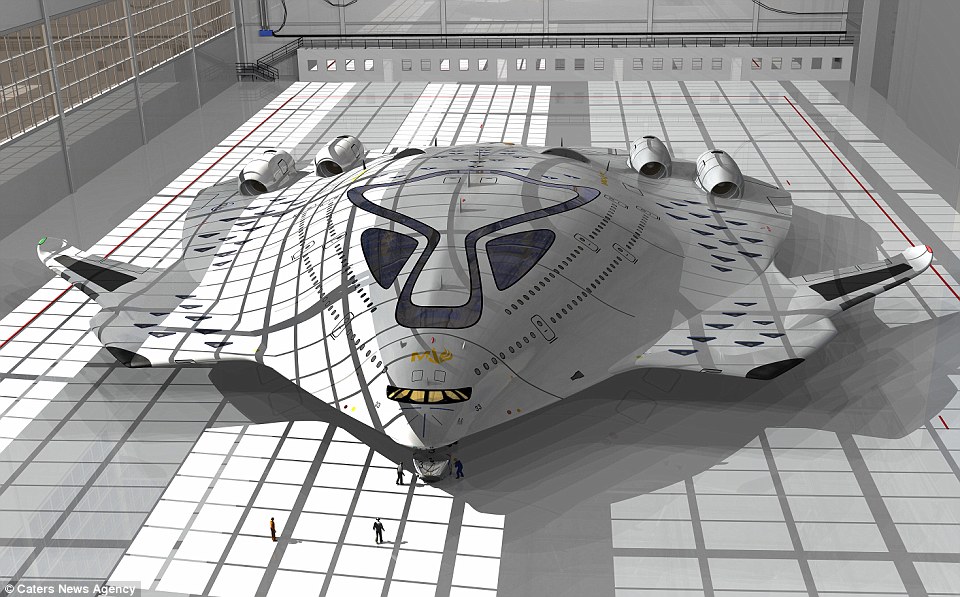These eye-opening designs propose a future of flight that is both supersonic and eco-friendly.
The spaceship-like plans for the HSP ‘Magnavem’ feature a streamlined ship capable of reaching a top speed of Mach 1.5 (1,150mph/1,852km/h).
The hypersonic plane would cut travel times between New York and London to just three hours, more than halving the duration of current flights.
What’s more, the amazing aircraft will produce zero carbon emissions, thanks to the compact fusion reactor that will power it.
According to designer Oscar Vinals, the craft, which he hopes will revolutionise the aeronautic industry, will run primarily on a compact fusion reactor (CFR).
This reactor, the plans say, would provide the Magavem with an incredible amount of electrical energy – all at no cost to the environment.
Nuclear fusion is the process by which the sun works. Compact fusion reactors will mimic that process within a magnetic container and release energy from hydrogen in a controlled fashion to produce power we can use.
In total, Mr Vinals believes his lightweight aircraft could carry some 500 passengers, and due to the technologies he proposes using, the ‘Magnavem’ can be recharged extremely quickly.



Mr Vinals, from Barcelona, Spain, has been working on the designs for more than a year.
They also feature a carbon dioxide cleaning system, adding to the environmental benefits of the craft.
An internal AI system would optimise the craft’s functions, while plasma actuators control the airflow to the wings and over the fuselage.
The chosen name, ‘Magnavem,’ comes from the latin ‘magna avem,’ meaning ‘big bird.’



While the craft could theoretically be built today, Oscar said, certain technologies are still in the ’embrionary stage,’ and so 10 to 15 years of advancements may be needed in order to complete such a flying vessel.
Mr Vinals, 40, said: ‘The response has been totally positive. I am very happy with this.
‘I am most excited about the possibility to use a CFR (compact fusion reactor) with the benefits of inexhaustible power and great amounts of energy production.
‘There’s also the plasma energy to control the airplane’s flight or the use of AI system.
‘We must not forget the possibility of using the plane like a efficient tool to “clean” the excess of CO2 in the atmosphere.’
More than 50 years ago, nuclear power through fission was the excitement of its day. People tried using it to power almost everything, even planes. In the end, operational hurdles prevented fission from widespread use.



While fission continues to power our nuclear reactors today, fusion offers a cleaner, safer source of energy.
Fission occurs when one atom is split into two smaller fragments, creating an explosion of sorts and resulting in the release of heat energy.
Fusion is the process by which a gas is heated up and separated into its ions and electrons.
When ions get hot enough, they can overcome their mutual repulsion and collide, fusing together. When this happens, they release a lot of energy – about one million times more powerful than a chemical reaction and three to four times more powerful than a fission reaction.
The fusion reaction that is easiest to accomplish is between two isotopes of hydrogen: deuterium, extracted from water, and tritium, produced during the fusion reaction through contact with lithium.


When deuterium and tritium nuclei fuse, they form a helium nucleus, a neutron and a lot of energy.
A reactor small enough to fit on a truck could provide enough power for a small city of up to 100,000 people.
This is not the first time that nuclear power has been proposed as a fuel for flight, with one aircraft that flew in the West during the cold war actually came close to achieving this aim.
During the early 1950s, a heavily modified Convair B-36 bomber built by the US Air Force called the NB-36H flew a total of 47 times, although the onboard reactor was only tested in the air and never to power the aircraft.
The behemoth was further weighed down with 11 tonnes of shielding to keep radiation at bay.













